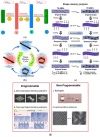Advanced Functional Materials for Intelligent Thermoregulation in Personal Protective Equipment
- PMID: 34771268
- PMCID: PMC8587695
- DOI: 10.3390/polym13213711
Advanced Functional Materials for Intelligent Thermoregulation in Personal Protective Equipment
Abstract
The exposure to extreme temperatures in workplaces involves physical hazards for workers. A poorly acclimated worker may have lower performance and vigilance and therefore may be more exposed to accidents and injuries. Due to the incompatibility of the existing standards implemented in some workplaces and the lack of thermoregulation in many types of protective equipment that are commonly fabricated using various types of polymeric materials, thermal stress remains one of the most frequent physical hazards in many work sectors. However, many of these problems can be overcome with the use of smart textile technologies that enable intelligent thermoregulation in personal protective equipment. Being based on conductive and functional polymeric materials, smart textiles can detect many external stimuli and react to them. Interconnected sensors and actuators that interact and react to existing risks can provide the wearer with increased safety, protection, and comfort. Thus, the skills of smart protective equipment can contribute to the reduction of errors and the number and severity of accidents in the workplace and thus promote improved performance, efficiency, and productivity. This review provides an overview and opinions of authors on the current state of knowledge on these types of technologies by reviewing and discussing the state of the art of commercially available systems and the advances made in previous research works.
Keywords: performance; personal protective equipment; productivity; smart textiles; thermoregulation.
Conflict of interest statement
The authors declare no conflict of interest.
Figures










Similar articles
-
Towards real-time thermal stress prediction systems for workers.J Therm Biol. 2023 Apr;113:103405. doi: 10.1016/j.jtherbio.2022.103405. Epub 2022 Nov 30. J Therm Biol. 2023. PMID: 37055098 Review.
-
Characterization and Modeling of Thermal Protective and Thermo-Physiological Comfort Performance of Polymeric Textile Materials-A Review.Materials (Basel). 2021 May 5;14(9):2397. doi: 10.3390/ma14092397. Materials (Basel). 2021. PMID: 34062955 Free PMC article. Review.
-
Smart Textiles for Visible and IR Camouflage Application: State-of-the-Art and Microfabrication Path Forward.Micromachines (Basel). 2021 Jun 30;12(7):773. doi: 10.3390/mi12070773. Micromachines (Basel). 2021. PMID: 34208985 Free PMC article. Review.
-
Flexible and Robust Biomaterial Microstructured Colored Textiles for Personal Thermoregulation.ACS Appl Mater Interfaces. 2020 Apr 22;12(16):19015-19022. doi: 10.1021/acsami.0c02300. Epub 2020 Apr 8. ACS Appl Mater Interfaces. 2020. PMID: 32216294
-
Smart Protective Glove for Personal Protective Equipment (PPE) Against Chainsaws for Arborists.Materials (Basel). 2025 Feb 25;18(5):1010. doi: 10.3390/ma18051010. Materials (Basel). 2025. PMID: 40077236 Free PMC article.
Cited by
-
Heat Strain Evaluation of Power Grid Outdoor Workers Based on a Human Bioheat Model.Int J Environ Res Public Health. 2022 Jun 26;19(13):7843. doi: 10.3390/ijerph19137843. Int J Environ Res Public Health. 2022. PMID: 35805501 Free PMC article.
-
Climate change and heat stress resilient outdoor workers: findings from systematic literature review.BMC Public Health. 2024 Jun 26;24(1):1711. doi: 10.1186/s12889-024-19212-3. BMC Public Health. 2024. PMID: 38926816 Free PMC article.
-
PVDF/AgNP/MXene composites-based near-field electrospun fiber with enhanced piezoelectric performance for self-powered wearable sensors.Int J Bioprint. 2022 Nov 24;9(1):647. doi: 10.18063/ijb.v9i1.647. eCollection 2023. Int J Bioprint. 2022. PMID: 36844238 Free PMC article.
References
-
- Jacklitsch B. Criteria for a Recommended Standard: Occupational Exposure to Heat and Hot Environments. Centers for Disease Control and Prevention; Atlanta, GA, USA: 2016.
Publication types
LinkOut - more resources
Full Text Sources

